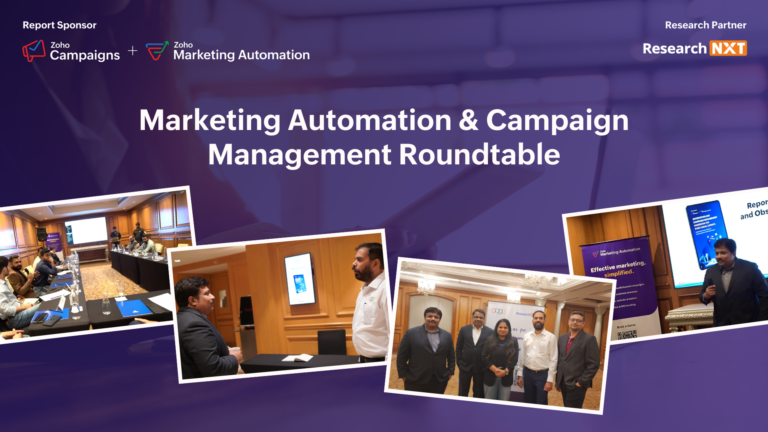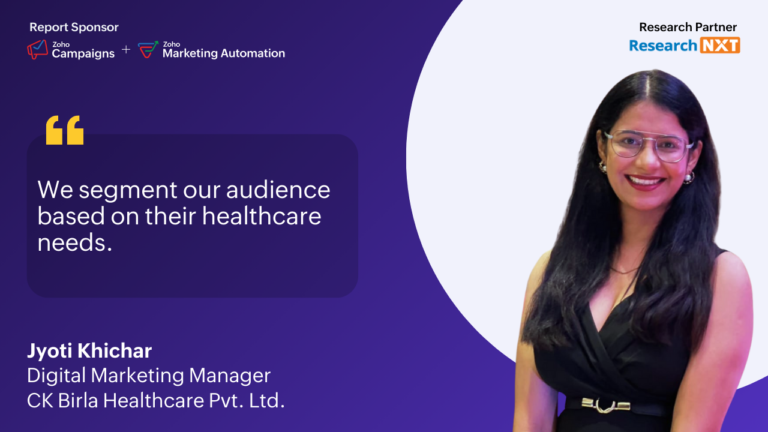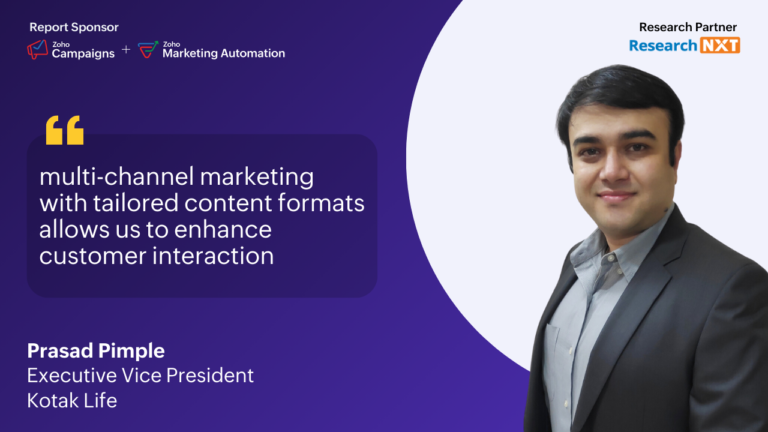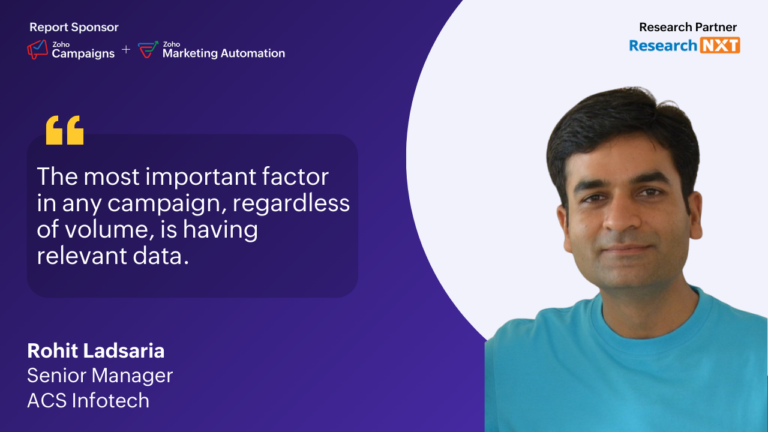"Marketing automation is not just a tool for efficiency but a driver of business success"
In this Research NXT Interview, Naresh Kumar, Member Leadership Staff at Zoho, discusses his journey within the organization, the opportunities with one-stop solutions, and the flexibility for users to choose as they advance in their marketing journey. He emphasizes the challenges of managing data across various platforms and how Zoho strives to build an omni-channel platform instead of multi-channel options.
Key takeaways from this Research NXT interview:
- Zoho being a one-stop solution for marketing needs with go-as-you-grow flexibility for the end user.
- The benefits of minimizing data silos to empower marketers to manipulate and organize data to meet specific contact and campaign needs.
- How Zoho Marketing Automation aids customers in selecting their preferred attribution models to measure marketing ROI specific to individual organization needs.
- Additionally, he sheds light on the impact, limitation and possibilities of AI in optimizing marketing automation and campaign management.
"We value customer feedback, and it has helped us structure our products to empower marketers in addressing problems associated with data silos and contact segmentation in a customized manner."
Thank you for taking time out of your busy schedule for this discussion. We’d like to start with a brief description of your journey and role at Zoho. So, we would like to know your journey as an individual and then your journey within the organization.
Naresh: I have been working with Zoho for seven years now. I started as a product manager for Zoho PageSense. After PageSense, I was also involved in the development of Zoho Campaigns and Zoho Marketing Automation. Over the past seven years, my main focus has been product management and I have also helped teams on various customer-facing aspects such as pre-sales, implementation, and support. Before Zoho, I worked with a couple of other firms, Zoho being my fifth company. I’d say I have been in the martech ecosystem for more than a decade now.
What are your observations on the evolution of martech space in India?
Naresh: In the early 2010s, there were only a few SaaS providers in the martech space from India. Most of the providers were predominantly from Silicon Valley and other parts of the world. Zoho and Netcore were among the early Indian providers. However, post 2010s, we have seen a lot of other companies coming into the martech ecosystem. I believe we currently have over 100 startups operating from India. The martech space has evolved substantially, with intense competition among the many players.
Read More
Today, Zoho has multiple products across various segments of the martech landscape. Tell us, how has Zoho as an organization evolved over the years with respect to the martech landscape?
Naresh: I believe that Zoho is the only company in the market that offers such a wide range and depth of features and functionalities. From email marketing to website optimization to surveys, we have everything that a marketer needs in our suite. This allows marketing teams and organizations to trust Zoho as a one-stop solution for all their marketing needs. We also offer flexibility for the end user – they can start with one tool or a couple of tools and then move on to buying bundles and suites. For instance, we have the Marketing Plus, which is the marketing bundle, and Zoho One, which includes not only the marketing products but all our other products as well. This flexibility allows the end user to choose their preferred approach. Additionally, having a single database and a single organization offering all these solutions is beneficial for a marketing department in many ways.
As someone working very closely with the martech initiatives of leading brands, what are the usual functional challenges marketers face in executing successful multi-channel marketing campaigns?
Naresh: One of the major issues marketers face while implementing marketing automation is managing scattered data across multiple platforms. Data silos are a key problem that many organizations encounter, which has led to a rise in Customer Data Platforms(CDPs). Our Zoho Marketing Automation solution tries to minimize this issue by integrating with various tools, allowing marketers to manipulate and organize data to meet specific contact needs. We value customer feedback, and it has helped us structure our products to empower marketers in addressing problems associated with data silos. In addition, we are trying to democratize the way in which data is incorporated into the system so that marketers can use it for contact filtering and segmentation.
Connected to the previous question, how has Zoho been instrumental in addressing and simplifying the critical marketing technology needs of marketing campaign management experts through its products? Could you please share some use cases and their impact?
Naresh: Keeping track of a customer’s interactions across different platforms can be challenging. That’s why our marketing automation aims to be an omni-channel platform, allowing you to run campaigns and manage customer data all in one place. With Zoho’s marketing automation, you can access a comprehensive view of each contact, including their website activity, email and WhatsApp campaign history, and event participation. This all-in-one view lets you filter and analyze the data as needed. When our integrations are in place, and data flows seamlessly between tools, you’ll have a complete 360-degree view of your contacts right within our platform.
As marketing automation tools and strategies are increasingly adopted by businesses in India, measuring ROI is a significant challenge for marketers in every campaign. Based on your observations, what are the key metrics used for measuring ROI and what are the industry standards for the same? How does Zoho assist its customers in managing ROI through the Zoho platform?
Naresh: The measurement of ROI depends on the attribution model you choose to use, which serves as the starting point. Most of our customers opt for either the first-touch or last stage attribution models and then customize them further to measure the ROI. We begin with the attribution model and consider it a critical challenge that requires integration with various platforms and avenues for tracking the generation of specific contacts. In our marketing automation, we support these functionalities and aid customers in selecting their preferred attribution models from the six options available.
We also offer seamless integration with CRMs such as Salesforce and Sugar CRM. For instance, integrating with MS 365 allows us to fetch data on deals and other relevant information into the system. This enables us to capture data points such as the source of a contact and its conversion, along with insights into ad expenses. We calculate the entire ROI cycle based on this information.
Additionally, our marketing automation system includes a “planner” feature that allows users to plan their marketing activities, allocate budgets, measure expenses, and track conversions, ultimately providing insights into ROI. When we engage with customers or marketing professionals, we emphasize the importance of measuring both tangible and intangible benefits. Tangible benefits, such as revenue, are measurable, while intangible benefits, like brand awareness and social media impact, require more thoughtful evaluation. We are also working on incorporating features to measure intangible benefits within our product for the end user.
What are the key trends you have observed when it comes to marketing automation and campaign management from a global and an Indian perspective?
Naresh: AI has been on the rise in the last couple of years. Generative AI is being used to create content recommendations or generate images for email and landing pages. Predictive AI is another technology that is being used to predict the performance of different customer segments for campaigns or predict the segments most likely to convert. These technologies are going to be popular and widely used in the upcoming years.
Another use case of AI is hyper-personalization, which refers to the creation of highly personalized content for campaigns and it is likely to boost conversions. Although we have had personalization for some time now, there have been issues such as incorrect recommendations or irrelevant content which have affected customer experience. AI will allow us to scale personalized content recommendations and eliminate the existing issues associated with personalization.
Apart from AI, another aspect that marketers are going to focus on in the coming years is customer retention. Automations and hyper-personalized content are going to be used for retention management. Considering the high costs associated with ads and lead generation, it’s crucial to prioritize the returns from existing customers and generate more revenue from them. This trend is expected to gain traction in the next few years.
Thank you for being candid and openly discussing the AI glitches in automating campaigns. With existing AI tools and your team’s ongoing development, what are your insights on AI’s current limitations in personalization, necessitating human intervention?
Naresh: Currently, some technical problems and challenges with personalization are faced while using AI. The problem lies in the fact that most organizations are using generative AI models designed by other organizations to model their own email campaigns and other aspects. However, at Zoho, we have our own lab team developing our own LLM models and generative AI. Instead of relying on only one generative model, we have three to four generative models which we work on independently. In addition, privacy and data security are key aspects that are important to us. At Zoho, we don’t use customers’ data to train our model.. We use our own data models and train the AI. Once the AI starts interacting with customers’ data points for an individual organization, it only uses the respective organization’s data. This way it would be able to create a more personalized and intuitive experience for an individual organization. In general, there are large LLM models in the market where data is taken from multiple sources and is not unique to a particular business or set of contacts which they are running campaigns for. Our goal is to provide more tailored AI-driven solutions suited for an individual business’s specific needs.
Before wrapping up, as a functional marketer and being closely in touch with the customer base in India, what are your expectations in terms of what this report should entail for the readers?
Naresh: In this day and age, marketing professionals and functional leaders will need to analyze various data points to determine which databases to measure and which metrics to focus on. This information is crucial for optimizing campaigns, improving team performance, and making informed investment decisions. A comprehensive report covering these avenues, while providing best practices for each aspect of marketing, would be extremely valuable for any marketing leader.






